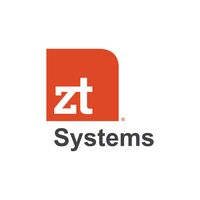AMD's Strategic Shift: Selling ZT Systems to Sanmina for $3 Billion
May 23, 2025, 10:24 am
In a bold move, AMD has sold its server manufacturing business, ZT Systems, to Sanmina for $3 billion. This decision is a significant pivot for AMD, highlighting its focus on domestic chip production amid rising global trade tensions. The sale comes on the heels of AMD's acquisition of ZT Systems for $4.9 billion just a year prior. The tech landscape is shifting, and AMD is navigating these waters with a keen eye on the future.
The backdrop of this transaction is a complex tapestry of geopolitical and economic factors. The U.S. semiconductor industry is under pressure to ramp up domestic production. The push for self-sufficiency in chip manufacturing has gained momentum, especially in light of supply chain disruptions caused by the pandemic and ongoing trade disputes. AMD's decision to divest ZT Systems underscores its commitment to strengthening its core business while responding to these external pressures.
Forrest Norrod, AMD's executive vice president, emphasized the company's intention to bolster its manufacturing capabilities in the U.S. This is not just about selling off assets; it's about positioning AMD for the future. The focus will be on artificial intelligence (AI) systems, which are becoming increasingly critical in today's tech landscape. The demand for AI computing power is skyrocketing, and AMD aims to capitalize on this trend.
By retaining ZT's AI system development business, AMD is keeping a vital piece of the puzzle. This segment is crucial as it aligns with the growing need for high-performance computing solutions. The AI market is a battleground, with competitors like Nvidia leading the charge. AMD's strategy is clear: streamline operations while enhancing its competitive edge in AI.
The sale of ZT Systems also reflects AMD's broader strategy to focus on its strengths. The company has faced challenges in the server market, particularly against Nvidia's dominance in AI processors. By divesting a segment that may not align with its long-term goals, AMD can concentrate on areas where it can innovate and lead.
The timing of this sale is noteworthy. As the tech industry grapples with fluctuating demand and economic uncertainty, companies are reevaluating their portfolios. AMD's decision to sell ZT Systems may be seen as a prudent move to ensure financial stability. The $3 billion from the sale can be reinvested into research and development, further enhancing AMD's capabilities in chip design and manufacturing.
The market reaction to the sale has been mixed. While some analysts had hoped for a higher sale price, the $3 billion figure still provides AMD with a substantial influx of capital. This capital can be a lifeline, allowing AMD to pivot and adapt to the rapidly changing tech landscape. The focus on AI and cloud computing is not just a trend; it's the future of technology.
In the broader context, AMD's sale of ZT Systems is part of a larger narrative in the semiconductor industry. Companies are consolidating, divesting, and realigning to stay competitive. The landscape is evolving, and those who can adapt will thrive. AMD's decision to sell is a strategic maneuver, one that reflects a deep understanding of market dynamics.
The tech industry is often likened to a game of chess. Each move must be calculated, anticipating the opponent's response. AMD's sale of ZT Systems is a strategic play, one that positions the company for future success. By shedding non-core assets, AMD can focus on its strengths and drive innovation in key areas.
As the dust settles on this transaction, the implications for AMD and the broader semiconductor market will unfold. The company is poised to strengthen its position in the AI space, a sector that promises immense growth. The sale may have been a tactical retreat, but it sets the stage for a more robust offensive in the future.
In conclusion, AMD's sale of ZT Systems to Sanmina is more than just a financial transaction. It is a reflection of the company's strategic vision and adaptability in a volatile market. As AMD continues to navigate the complexities of the tech landscape, its focus on AI and domestic production will be crucial. The road ahead is filled with challenges, but with a clear strategy, AMD is ready to seize the opportunities that lie ahead. The chess game continues, and AMD is making its moves with precision and purpose.
The backdrop of this transaction is a complex tapestry of geopolitical and economic factors. The U.S. semiconductor industry is under pressure to ramp up domestic production. The push for self-sufficiency in chip manufacturing has gained momentum, especially in light of supply chain disruptions caused by the pandemic and ongoing trade disputes. AMD's decision to divest ZT Systems underscores its commitment to strengthening its core business while responding to these external pressures.
Forrest Norrod, AMD's executive vice president, emphasized the company's intention to bolster its manufacturing capabilities in the U.S. This is not just about selling off assets; it's about positioning AMD for the future. The focus will be on artificial intelligence (AI) systems, which are becoming increasingly critical in today's tech landscape. The demand for AI computing power is skyrocketing, and AMD aims to capitalize on this trend.
By retaining ZT's AI system development business, AMD is keeping a vital piece of the puzzle. This segment is crucial as it aligns with the growing need for high-performance computing solutions. The AI market is a battleground, with competitors like Nvidia leading the charge. AMD's strategy is clear: streamline operations while enhancing its competitive edge in AI.
The sale of ZT Systems also reflects AMD's broader strategy to focus on its strengths. The company has faced challenges in the server market, particularly against Nvidia's dominance in AI processors. By divesting a segment that may not align with its long-term goals, AMD can concentrate on areas where it can innovate and lead.
The timing of this sale is noteworthy. As the tech industry grapples with fluctuating demand and economic uncertainty, companies are reevaluating their portfolios. AMD's decision to sell ZT Systems may be seen as a prudent move to ensure financial stability. The $3 billion from the sale can be reinvested into research and development, further enhancing AMD's capabilities in chip design and manufacturing.
The market reaction to the sale has been mixed. While some analysts had hoped for a higher sale price, the $3 billion figure still provides AMD with a substantial influx of capital. This capital can be a lifeline, allowing AMD to pivot and adapt to the rapidly changing tech landscape. The focus on AI and cloud computing is not just a trend; it's the future of technology.
In the broader context, AMD's sale of ZT Systems is part of a larger narrative in the semiconductor industry. Companies are consolidating, divesting, and realigning to stay competitive. The landscape is evolving, and those who can adapt will thrive. AMD's decision to sell is a strategic maneuver, one that reflects a deep understanding of market dynamics.
The tech industry is often likened to a game of chess. Each move must be calculated, anticipating the opponent's response. AMD's sale of ZT Systems is a strategic play, one that positions the company for future success. By shedding non-core assets, AMD can focus on its strengths and drive innovation in key areas.
As the dust settles on this transaction, the implications for AMD and the broader semiconductor market will unfold. The company is poised to strengthen its position in the AI space, a sector that promises immense growth. The sale may have been a tactical retreat, but it sets the stage for a more robust offensive in the future.
In conclusion, AMD's sale of ZT Systems to Sanmina is more than just a financial transaction. It is a reflection of the company's strategic vision and adaptability in a volatile market. As AMD continues to navigate the complexities of the tech landscape, its focus on AI and domestic production will be crucial. The road ahead is filled with challenges, but with a clear strategy, AMD is ready to seize the opportunities that lie ahead. The chess game continues, and AMD is making its moves with precision and purpose.



